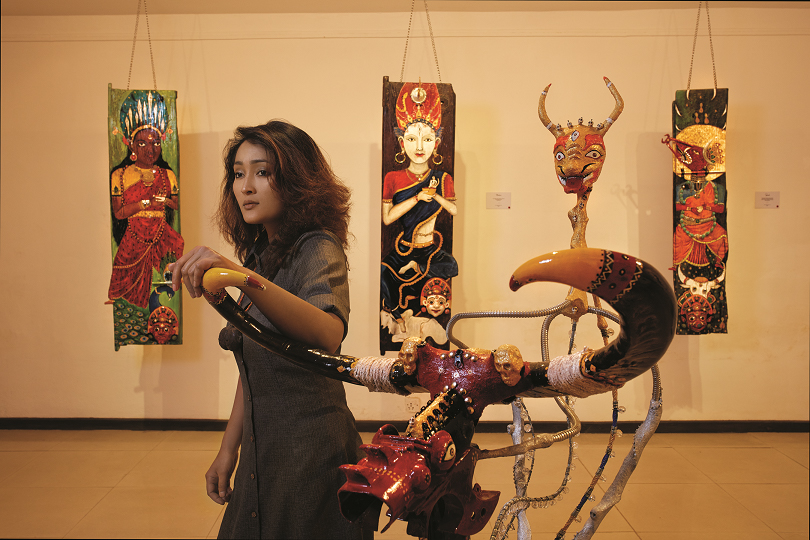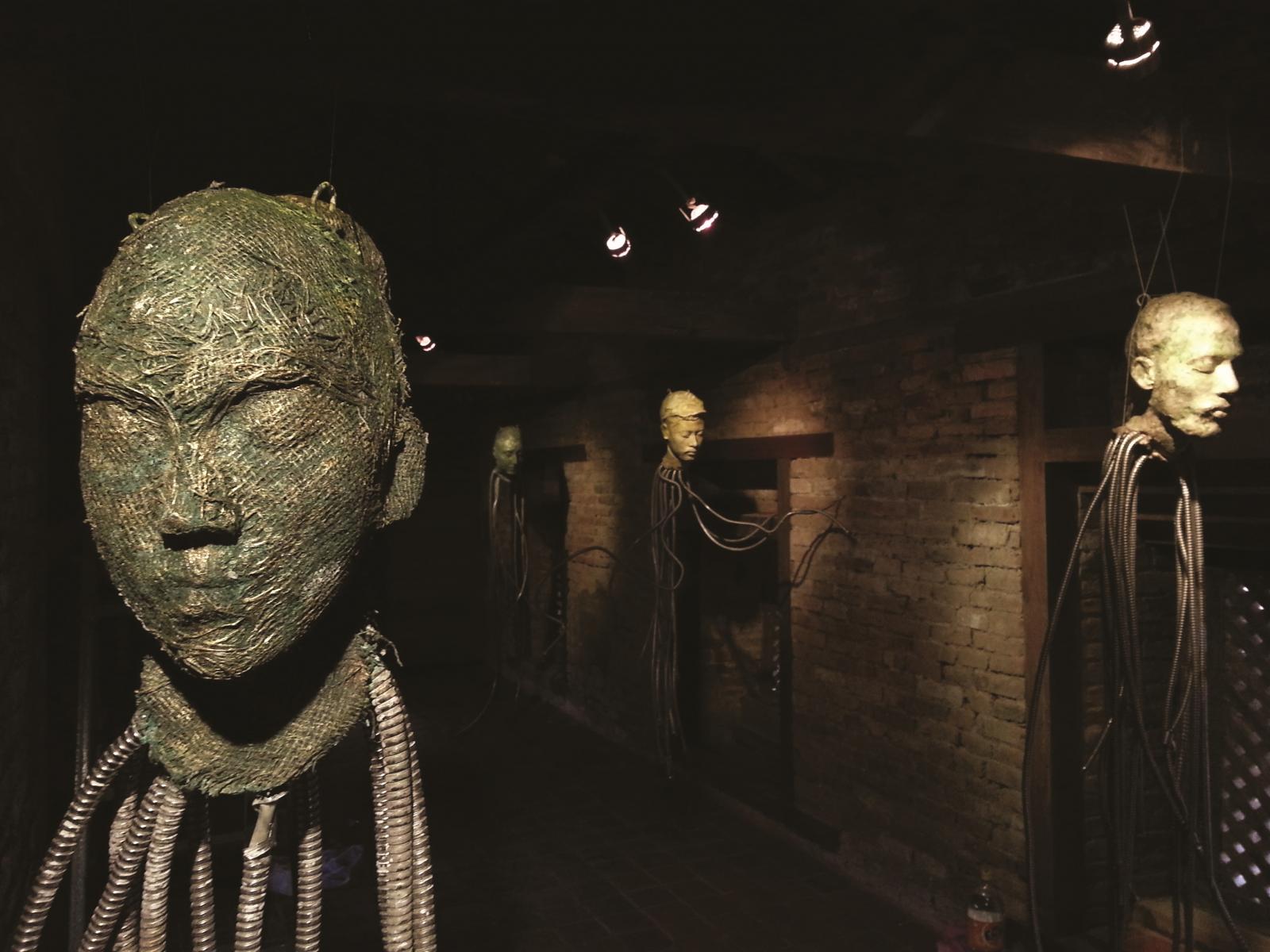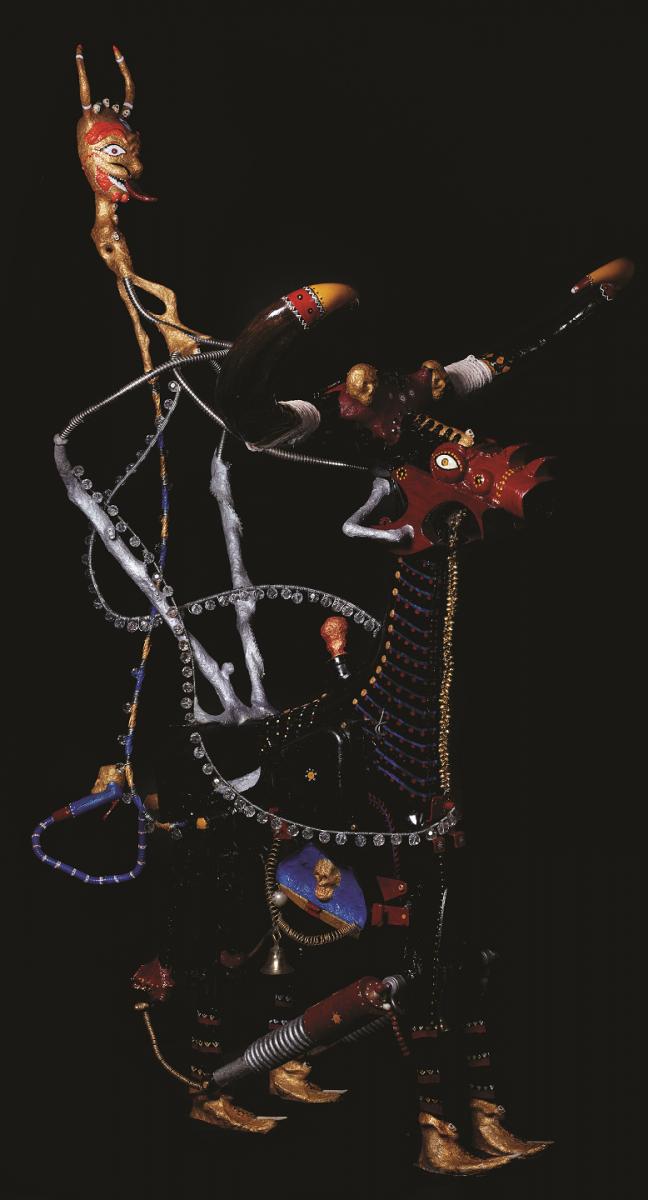Meena Kayastha: A Journey of Artistic Exploration and Self-Discovery
In our discussion with Meena Kayastha, shares with us how she came to choose art as her profession, as well as her early life, some of her works, and the meaning behind them.

Meena Kayastha is a Nepalese artist who has garnered global recognition for her unique artistic style, which blends traditional Nepalese art with modern techniques. Her work reflects her desire to bridge the gap between tradition and modernity, and her art often carries deeper meanings that touch the hearts of viewers. In this feature article, we will take a closer look at Meena Kayastha's journey as an artist and some of her experiences that led her to pursue a lifestyle of creativity in the field of art.
Meena Kayastha, a talented artist, was born in Nepal in 1985. Her childhood was heavily influenced by her family's passion for both education and the arts. Both of her parents were educators, and her father was also a painter, which inspired Meena to pursue her creativity from an early age. Growing up in a traditional Nepali family exposed Meena to the vibrant culture and traditions of her country, and she was particularly fascinated by the intricate designs and motifs found in Nepalese art and architecture. As she completed her SLC, her interest in art continued to grow, and she enrolled at the Srijana College of fine arts, the first private fine arts college in Nepal. Meena was part of the first batch of students in the institution, which consisted of only 16 students at that time. She further pursued her passion for art by completing a diploma at KU, school of arts and design, which was also the first-ever fine arts diploma in Nepal. Throughout her education, Meena honed her skills and developed her unique artistic style, which draws inspiration from her Nepali heritage and cultural roots. Her artwork has been exhibited in various galleries and art shows, both nationally and internationally, and she has received recognition and accolades for her exceptional talent.
Meena's dedication to her craft and her passion for exploring her creative side has made her a prominent figure in the Nepalese art scene, and her artwork continues to inspire and captivate audiences worldwide. The one-year program started with seven to eight students and later grew to over
During her time at university, Meena was exposed to a range of artistic styles and techniques, which helped to shape her own unique artistic style. She was particularly drawn to traditional Nepalese art forms such as Thangka painting and Newari art but also wanted to incorporate modern elements into her work through the use of sculptures. Meena's passion for art was fueled by her desire to explore and experiment with different mediums and techniques. One of the main reasons for her passion for the field of arts was because of her family business of traditional Nepali handicrafts in Bhaktapur, which she describes as very fun even at such a young age. Her parents were always supportive while she pursued her dream. Her final motivation was when she met her husband after she completed her SLC, who inspired her to reach new heights in the field and also taught her various aspects of art that she never knew.
Artistic Style and Influences
Meena Kayastha's unique artistic style is characterized by her use of vibrant colors, intricate patterns, and a fusion of traditional and modern techniques. Her sculptures are a reflection of her deep connection to Nepalese culture and traditions and her desire to explore and experiment with new forms of artistic expression. She describes artists as being influenced by many factors in their day-to-day lives, such as religion, culture, environment, etc. The influence of these factors cannot be avoided, as each piece is a representation of one's soul. Her art style leans more towards the social, cultural, and religious, but is always changing.
She describes her way of making different cultures as a creative and fun way to express her ideas that are manifested in the piece. While in the process of making any art piece, she describes the feeling of working on an empty canvas, where ideas come at any moment. Each mold of the sculpture or stroke of the brush gives meaning to the next. When making her pieces, she goes with the flow until she reaches a point where she maps out the steps that lead to the final sculpture, which is usually the halfway point.
Meena is a well-known artist whose main medium of art is sculpture. However, what makes her work stand out is her unique approach to creating art. She primarily makes use of discarded objects that people no longer have any use for, such as old newspapers, broken toys, and other materials that would typically be thrown away. This approach not only allows Meena to create stunning and intricate sculptures, but it also gives her a sense of satisfaction and fulfillment. By taking objects that are no longer wanted or valued and turning them into works of art, she finds a way to give these materials a new life and purpose. Furthermore, the art-making process is also interactive in that she actively seeks out these discarded materials from various sources, such as flea markets, thrift stores, and even discarded items from people. This process of collecting and repurposing these materials is a crucial part of her art, as it adds another layer of meaning and depth to her creations.
This type of art is a testament to the power of creativity and resourcefulness. By using discarded materials in her sculptures, she not only showcases her incredible talent but also raises important questions about our relationship with the objects we use and discard in our daily lives.
Notable Works
Meena Kayastha's body of work includes a wide range of paintings and sculptures that explore themes of spirituality, nature, and human emotions. Her work is a testament to her ability to blend traditional Nepalese art with modern techniques and create something truly unique and inspiring.
The sculpture titled "Soulful Monster" represents the artist's journey of self-discovery. The piece features a bull, which represents power and strength, and a fish, which is known for its restlessness and vulnerability. The artist believes that when these two opposing characters are brought together, they create a unique entity that breaks the stereotypical narrative that power is only associated with male dominance. Despite their differences, the bull and the fish, when combined, create a fiercely strong and wild character that is also playful and joyful. The artist sees these opposing traits as part of their own identity, with the bull representing their strength and power while the fish symbolizes their vulnerability and cheerful nature. Meena also acknowledges that these two characters are created by a supreme power that is beyond human understanding, yet they exist within them and have played a significant role in shaping their destiny. To the artist, they are like a desert that contains the most beautiful garden, with opposing traits coming together to create something unique and beautiful.

The art sculpture titled "Evolving Consciousness" is a representation of the mind's ability to move in different dimensions in silent space. The sculpture features various tentacles that symbolize the mind's reach to touch different aspects present within us and bring them to the surface to manifest in the world. The process of manifestation often happens without our conscious awareness, but it still exists. When we choose to manifest a particular thought or idea in the world, we depend on the support of nature and our environment. To ensure that our choices do not disrupt the harmony of the environment that has given us so much, we need to choose materials wisely. The sculpture highlights the importance of paying homage to Mother Nature for providing us with the space and resources to evolve our consciousness and reach where we are today. "Evolving Consciousness" encourages us to be mindful of our choices and their impact on the environment as we continue to evolve our consciousness in harmony with the world around us.
The sculpture "Walking to the Music" is a tribute to her father, who was a musician and left behind many cherished memories after passing away. The artist believes that music is one of the best things created in this universe and relates it to the divine nature of cosmology. The sculpture features a traditional musical instrument called the "Madal," which represents Nepali and indigenous South Asian music. For the artist, the Madal symbolizes her father, who remains present in every aspect of her life even though he is no longer alive. The sound of the nearby temple bell that the artist wakes up to every morning also resonates with her journey through life, and she feels that her father guides her from the afterworld. The "Walking to the Music" is a personal and emotional sculpture that represents the artist's connection to her father and the power of music to transcend life and death.

In our discussion, Meena mentioned one of her works that she had a very emotional attachment to one of the first works she completed. During her exhibition at the university, a person approached her to buy her painting, which she turned down right away. The painting was of a festival in Bhaktapur, where all the people were celebrating a jatra. At a certain point in her artistic career, Meena came to the realization that, in order to survive as an artist and make a living from her art, selling her art pieces was a necessary step. This realization came with the understanding that money plays a vital role in an artist's ability to continue creating and sharing their work with the world. While this realization initially presented a challenge for Meena, it also provided her with the motivation to explore different ways of monetizing her art without compromising her creative vision. She began to learn more about the business side of the art world, such as marketing and pricing strategies and found ways to sell her art pieces without sacrificing their authenticity and integrity.
Moreover, Meena also recognized that selling her art pieces not only provided her with financial stability but also allowed her to connect with a wider audience and share her artistic vision with more people. By creating art that resonated with others and providing them with the opportunity to own a piece of her work, she was able to build a community of supporters who appreciated and valued her art.
In the end, Meena's realization that selling her art pieces was necessary for survival ultimately led her to a greater understanding of the role that art plays in society and the importance of finding a balance between creative expression and financial sustainability.
Conclusion
Meena Kayastha is a talented artist whose works are a reflection of her personal experiences, culture, and identity. Her paintings, installations, and sculptures are powerful and thought-provoking pieces that deal with themes such as gender, social inequality, and environmental issues. Meena's use of vibrant colors and intricate detailing is reflective of her Nepalese heritage and creates pieces that are both beautiful and powerful. As Meena continues to create new works, she is sure to continue to make a name for herself in the world of contemporary art. She also has a message for the readers who are aspiring artists in the country of Nepal: even though the country of Nepal is not as developed as the Western or neighboring countries, it still has plenty of opportunities for those who are willing to give time to their dreams.


